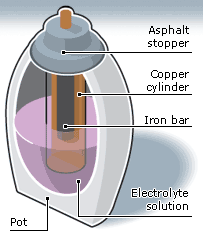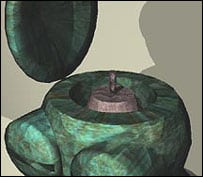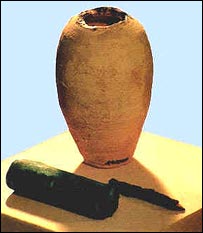Pokusy se podařilo replikovat tyto články a vyzkoušet funkčnost. Při testech se z článku podařilo dostat 0,8-1,2V dle použitého elektrolytu.
The mystery of the Baghdad batteries
Categories: Archaeology , Finds and rescue research abroad
Arran Frood is engaged in the production of the first galvanic cells. He is concerned about how to protect these archaeological and technological jewels, which are under threat due to the war tensions in Iraq. War can destroy far more than people, armies or leaders. Culture, tradition and history are also in its field of fire.
Iraq possesses a vast cultural heritage of humanity. It is said that the Garden of Eden and the Tower of Babel were located in this country.In every war, treasures of incalculable value are lost forever. For example, the "ancient batteries" that lie defenceless in Baghdad's museum.This discovery proves that the land that gave us writing and the wheel could also have invented the electric cell. Two thousand years before they became common knowledge.
|
"I don't think anyone can say for sure |
Biblical clues
Ithappenedin 1938 while working in Khujut Rab. Just outside Baghdad. There, German archaeologist Wilhelm Konig recovered a five-inch-long (13cm) clay vessel containing a copper cylinder that encased an iron wire.
The vessel showed signs of corrosion and initial tests indicated the presence of an acidic agent. Probably wine or wine vinegar.
In the early 20th century, many European archaeologists excavated the oldMesopotamian sites, looking for evidence of biblical stories like the Tree of Knowledge or Noah's Ark. Konig wasted no time pondering his find. For him, it was simply batteries. Despite the fact that his theory did not fit with the religious ideology of the time, nor could he prove it in any way, he published his results. Unfortunately, the world war broke out and his discovery was forgotten.
Scientific reflections
More than sixty yearsafterthe discovery, the Baghdad batteries remain. There are approximately 12 of them and they are still shrouded in myth. "As a rarity, the battery has always attracted interest," says Dr Paul Craddock of the British Museum, an expert on metallurgy in the ancient Near East. "They are absolutely unique. As far as we know, no one has found anything like them. They are one of the mysteries of life. It's also a mystery that the accounts of how they were found don't match. Some say they were dug up. Others say Konig found them in the basement of the Baghdad museum when he became director. There is no mention of how many were originally found. Their age is also disputed.
Most sources date them to 200 BC. To the Parthian Empire period (c. 250 BC to 225 AD). However, the Parthians are known for their military expertise rather than scientific discoveries."Although the collection is commonly dated to the Parthian Empire, the basis for this is unclear," recalls Dr St John Simpson, of the Ancient Near East Department. "The vessel itself is Sassanian. However, the controversy relates to a poor estimate of the age of the pottery vessel and also where it was discovered.
The basic principles
 The batteries date to 200 B.C. They may have been used for gilding |
In the history of the Middle East, the Sasanian period (c. 225 - 640 AD) marks the end of antiquity and the beginning of the more scientifically based Middle Ages. Although most scholars agree that the devices served as batteries, there is much conjecture as to how they may have been invented or what they were used for.
How did ancient Persian scientists understand the principle of electricity and come to this knowledge?
Maybe they didn't. Many inventions were made before their basic principles were formulated.
The Chinese invented gunpowder long before combustion was defined. Even today, the rediscovery of ancient herbal medicines is common. You don't always have to know how something works. Just that it works.
Enough energy
It iscertain that the Baghdad batteries could conduct electricity because many replicas of them were made. Including those made by ancient history students under the supervision of Dr. Marjorie Senechal, professor of the history of science and technology at Smith College, US. "I don't think anyone can say for sure what they were. But they could have been batteries, because that's how they work. "Creating an electric current requires two materials with differentand the ability to carry ions, known as electrolytes, to transport electrons between them. If they were connected in series, a set of batteries could theoretically generate a much higher voltage. But no wires have ever been found to confirm this.
"It's a pity we haven't found any wires," says Dr Craddock. "It means our explanation could have been wrong."
But he is absolutely certain that these are batteries and that there may be more. "Other specimens may lie unrecognised in museums." The most likely case is if a part is missing. Objects resembling batteries.
Possible uses
Batteriesmay have been used in medicine, for example. The ancient Greeks described the anaesthetic effect of an electric fish when applied to the soles of the feet. The Chinese, who had already invented acupuncture by then, used it in combination with an electric current. This may explain the presence of needle-like objects found in some batteries. However, this tiny voltage would have been ineffective. For the ancients knew much more effective anaesthetics such as cannabis, opium or wine.
Other scientists believe that batteries were used for electroplating - transferring a thin layer of metal onto another metal surface - a technique still used today in common school experiments. This idea is appealing because plating is the mother of many inventions: for example, the production of coins. In goldsmithing, for example, a layer of gold or silver is added to a piece of jewellery to enhance its beauty. This process is called gold plating.
Wine electrolytes
Two techniques of gold plating wereformerlyused and are still used today: Hammering the precious metal into thin slices using brute force or by mixing it with a mercury base, which is then transferred to the product.
These techniques are effective but costly compared to adding a thin but consistent layer of metal applied using electricity. The mysterious ability to electroplate objects with gold or silver not only saved raw materials and money, but could also secure you powerful friends at court.
 Could batteries have been placed inside idols? |
A palace, a kingdom, or even a sultan's daughter could be the reward for such knowledge - a reason to keep it secret.
In the 1970s, Dr. Arne Eggebrecht, then director of the Roemer and Pelizaeus Museum in Hildesheim, combined several Baghdad batteries and, using grape juice and electrolytes, created a layer of silver only one thousandth of a millimeter thick.
Other scientists questioned the results because they were unable to repeat the experiment. "There is no written documentation for these results, which took place here in 1978," says Dr Bettina Schmitz, a current researcher at the same Roemer and Pelizaeus museum. "The experiments were not even documented photographically, which is a real shame," she adds. "I have searched the museum archives and talked to everyone who was here in 1978, but to no avail."
Although it is possible to increase the voltage by connecting several batteries together, the resulting current is very weak. Many people believe that it would be impossible to achieve very high electric current even using dozens of Baghdad batteries.
The biggest flaw in the electroplating hypothesis is the lack of objects from the site and how they were handled."In this area and time, gold plating with mercury was common," explains Dr. Craddock. "There is no direct evidence to support the electroplating theory." He speculates that a group of batteries connected in parallel may have been hidden in an iron statue or idol.
He thinks whoever touched the statue received a small but noticeable electric shock. Something akin to a static electricity shock. "I've always been convinced there were tricks being performed in the temple," says Dr Craddock. "A statue of a god would be wrapped in wire and the priest would ask you questions." "If you answered wrong and touched the statue, you'd get a little shock. Maybe even aided by a flash of blue light. You answered correctly and the priest or the shifter disconnected the batteries and there was no shock. One was convinced of the power of the statue, the priest and religion."
Magical rituals
Itis said that it is impossible for the uninitiated to distinguish science from magic. "In Egypt, the hero engine is known to have been used in this way," Dr. Craddock adds. The hero engine was a primitive, steam-powered device. As with the Baghdad battery, no one is clear exactly what they were used for. But everyone is convinced they worked.
The object with the batteries inside could, like the Delphic oracle, have been worshipped and endowed with divine powers.
Even if the current was insufficient to provide a real shock, it could heat or tingle if touched by an unsuspecting finger.
And last but not least, it could have just been a vessel.
It may be too soon to say that the batteries were used to demonstrate a magical ritual. More research will be needed to answer this mystery, including the exact dating of the batteries and all its components.
No one knows if there really is a statue hiding the batteries. But there may soon be a chance to find out - if the objects survive the coming war in the Middle East. "These finds belong to the heirs of the people who made them," concludes Dr Craddock. "Hopefully the world will sort out its current problems and people will be able to come and see them."
---
You probably won't find a Baghdad battery in the country, but you can certainly find ordinary ones with our metal detectors.
The article is included in categories:
- Archive of articles > Archaeology
- Archive of articles > Archaeology > Finds and rescue research abroad
Post
Zajímavé čtení 

Dokonce ještě před pár desítkami let používali řemeslníci ve svých dílnách na bazarech články téměř shodné koncepce a to především k pokovování. Když to vědci zjistili, byli velmi překvapeni, jak tato konstrukce dokázala přežít tak dlouho až do novověku. 

Jo ještě existují dohady o tzv. Džedovém sloupu ze Starého Egypta, že se jednalo o osvětlovací těleso s využitím elektrického zdroje. 
PS: doplnění k bazarům, zapoměl jsem napsat, že v Iráku.... 










